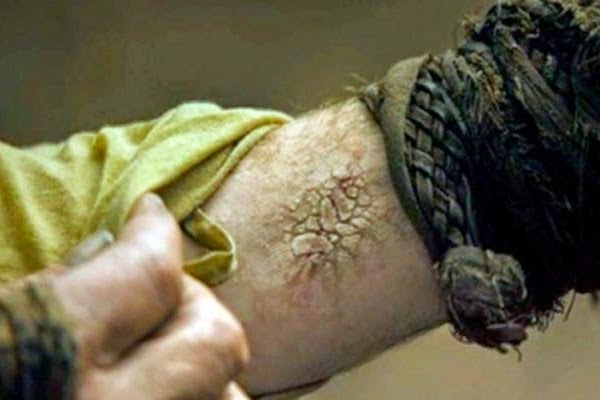[Obvious warning is obvious: potential spoilers for A Song of Ice and Fire novels/Game of Thrones TV series below].
While no one will claim that George R.R. Martin's epic series, "A Song of Ice and Fire," is historically accurate, there are a number of historical parallels that can be drawn from the characters and plotline--particularly from medieval Europe. While most of those relate to epic battles or former monarchs or other royalty, another of Martin's characters, so to speak, is the disease greyscale (1).
Greyscale is a contagious disease that seems to come in at least two distinct forms: greyscale, an endemic and slow acting, highly contagious illness that can affect either adults or children; and the grey plague, a rapidly-spreading epidemic that can wipe out entire swaths of cities in a short period of time. Both versions of the illness have a high fatality rate (no exact details are given, but it seems to be close to 100%, especially in adults). Recovery from greyscale makes one immune to outbreaks of grey plague, so they seem to be caused either by the same microbe or ones which are very closely related.
The Epidemiology of Greyscale
Greyscale is a disfiguring disease. As its name suggests, it transforms the skin into a hardened, scaly tissue. As the skin dies, it becomes grey in color with permanent cracks and fissures. Infection that spreads across the face can cause blindness.
Like many diseases we consider to be "childhood" diseases (measles, mumps, smallpox, chickenpox, etc.), children seem to be spared the worst of the disease and are the most likely to recover from the illness, though recovery still appears to be quite rare. The disease is most common in Essos, but can also be found occasionally throughout Westeros, including north of the Wall (more on that below).
Greyscale is believed to be transmitted primarily person-to-person via direct skin contact. We see this in the books with the infection of Jon Connington and on the TV show with Jorah Mormont, as both characters are transporting/protecting Tyrion Lannister and apparently are exposed to the pathogen during a battle with the Stone Men (2, 3). The Stone Men are victims in the last stage of greyscale infection, where the skin is entirely calcified and there is involvement of muscle, bone, and internal organs, including the brain. Late signs of greyscale infection include violent insanity, leading sufferers to violently attack anyone who comes near. As these Stone Men are highly feared as sources of the disease, greyscale appears to be contagious for the entire duration of infection, from the development of symptoms to near-death.
 A Stone Man with late-stage greyscale infection.
A Stone Man with late-stage greyscale infection.
If a person has been exposed to greyscale, but is not yet showing symptoms, they can check for impending infection by pricking their toes and fingers each day. Once they're no longer able to feel the knife, that's bad news--greyscale infection is likely, as insensitivity to touch is one of the early signs. Once the scaling begins, the victim no longer feels any pain in the affected areas, making the Stone Men essentially invulnerable to pain.
The incubation period of greyscale seems to be very short. As soon as Jorah and Tyrion realize they are safe and the Stone Men are defeated, Jorah rolls up his sleeve and we see that the initial small patch of greyscale has already appeared.
 First appearance of Jorah's greyscale following fight with Stone Men.
First appearance of Jorah's greyscale following fight with Stone Men.
Another prominent victim of greyscale, Shireen Baratheon, is thought to have acquired greyscale via contact with a fomite (an inanimate object that serves as a vehicle to transmit an infectious agent between people)--in her case, a beloved wooden doll clothed in Baratheon House colors from when she was an infant. Her father, Stannis, implies that this may have been a form of bioterrorism--that Stannis received the doll from a Dornish trader on Dragonstone. He tells his daughter, "No doubt he'd heard of your birth, and assumed new fathers were easy targets" (S05E04). "I still remember how you smiled when I placed that doll in your cradle, and you pressed it to your cheek," where evidence of greyscale is still present (4).
 Shireen Baratheon with facial greyscale.
Shireen Baratheon with facial greyscale.
Treatment
A number of remedies have been proposed to treat greyscale, but none of them are proven effective. They include treating it with boiling water containing limes; chopping off of the infected limbs; religious means/magic; and maybe fire--in A Dance with Dragons, Tyrion touches a Stone Man with his torch, and the Stone Man shrieks in pain (even while having bone showing through his skin, which apparently doesn't bother him). Whether fire could be a cure is unclear.
Also in A Dance with Dragons, we read of Tyrion's musings on treating greyscale: "He had heard it said that there were three good cures for greyscale: axe and sword and cleaver. Hacking off afflicted parts did sometimes stop the spread of the disease, Tyrion knew, but not always. Many a man had sacrificed one arm or foot, only to find the other going grey. Once that happened, hope was gone." As such, the infectious agent seems to enter into the bloodstream and spread throughout the body at some point during the infection, and at this point, local measures such as amputation are no longer useful. Other home remedies, such as cleansing the infected area with vinegar, are also employed. In fact, Jon Connington, once he realizes he's been infected, soaks his hand in bad wine instead of vinegar, because he believes that if he asks for vinegar, it will be an obvious "tell" that he has the disease.
In the TV series (S05E04), Stannis says to Shireen regarding her infection, "I called in every Maester in this side of the world, every healer, every apothecary. They stopped the disease and saved your life." However, no details are given on the show regarding how it was stopped (medicine? magic?), or if a mechanism exists that could be used on an adult instead of an infant. When Daenerys asks Jorah if there is a cure, he tells her simply that he doesn't know, and she directs him to leave, find one, and return to her.
Cultural response
Largely, those with greyscale are shunned and sent elsewhere, especially to the ruins of Valyria (5) where a whole colony of Stone Men live. Shireen asks Stannis, "Are you ashamed of me, Father?", understanding that her obvious greyscale scars are a sign of stigma for their entire family. Stannis tells his daughter, "Everyone advised me to send you to the ruins of Valyria to live our your short life with the Stone Men before the sickness spread throughout the castle. I told them all to go to hell." (Father of the Year before that whole burning stuff, Stannis!)
Similarly, both the books and show note the existence of greyscale beyond the wall among the Wildlings--and that the free folks' response to greyscale infection is exile and/or death. In the books, a wildling named Val sees Shireen, and notes Shireen has a condition they call "the grey death," which is always fatal in children--because they're given either hemlock, a pillow, or a blade rather than be allowed to live. She also suggests that greyscale may become quiescent and return later, saying "The grey death sleeps, only to wake again. The child [Shireen] is not clean."
On the TV version, the wildling Gilly takes the place of Val, and while she is not as frightened of Shireen's greyscale, she notes she's also had experience with the illness. She tells the tale of two of her sisters, who contracted greyscale (exactly how, we're not told). Though he did not kill them as Val suggested, Gilly noted that her father "made them move out of the keep, into the hut outside. None of them were allowed to go near them, but we heard them, especially at night. They started to sound not like themselves." Gilly saw them again "only once, at the end. They were covered with it. Their faces, their arms. They acted like animals. My father had to drag them out to the woods on a rope." Shireen doesn't find out what happened to them after that, but we can guess it's not good.
 Gilly and Shireen at Castle Black.
Gilly and Shireen at Castle Black.
What are some real-life parallels?
Clearly greyscale is another invention of Martin's that doesn't quite match up to any real infectious disease (6), and I'll leave that linked article to summarize some of the pros and cons of the alternative diagnoses. But given the other historical parallels, leprosy (Hansen's disease) is probably the closest real-life affliction to greyscale, due to the route of transmission (I'll elaborate on that below), symptoms, incubation period, and particularly the cultural response to those who are affected.
Like those with leprosy, sufferers of greyscale can become disfigured, are considered "unclean" and shuffled off to the far corners of the map, feared and then ignored by their family and friends. Connington, when hiding his infection, noted that "Queer as it seemed, men who would cheerfully face battle and risk death to rescue a companion would abandon that same companion in a heartbeat if he were known to have greyscale"--a similar phenomenon to what still can happen today with stigmatized diseases such as leprosy. A case of greyscale is a source of stigma for both the sufferer (even if they survive, like Shireen) and for the family, as there will always be those who fear contagion.
Though evidence is gathering that leprosy is actually transmitted via the respiratory route (like its cousin, tuberculosis), for centuries people believed it could be spread by touch, as greyscale is. So even though the transmission route for the two diseases really isn't the same, the *presumption* that leprosy can be spread by touch is still incredibly common. The lengthy period between infection and outward symptoms of the affliction is also similar, taking years from exposure to the final stages of infection that we see in the Stone Men. Leprosy can also take years or decades to progress, and while untreated leprosy is not typically a cause of death itself, it can lead to death indirectly due to secondary infections and other issues.
One of the early signs of leprosy is also numbness in an affected area as nerves are damaged by the infection, as Tyrion tried to evaluate after his exposure to the Stone Men, as well as a general thickening and stiffness of the skin. It doesn't get to the level that's seen with the Stone Men--one of the biggest problems with leprosy is actually secondary infections, which can lead to loss of digits or even whole limbs rather than a whole-body calcification of the skin--but many of the hallmarks of greyscale are very similar to leprosy.
While leprosy is now treatable with antibiotics, it wasn't all that long ago that we had our own leper colonies in the U.S. (you can read about one of them here, also on a near-deserted island where the afflicted were largely left to fend for themselves with some occasional governmental assistance, similar to Valyria/the Sorrows). Martin himself even notes that Valyria is "like a leper colony." Leprosy, and its stigma, remains an issue in some countries still today, and the purposeful isolation of those who have leprosy and exclusion from society persists.
 Image of the U.S. leper colony at Molokai, Hawaii, circa 1900.
Image of the U.S. leper colony at Molokai, Hawaii, circa 1900.
However, while there are many similarities, leprosy doesn't have an epidemic form equivalent to the grey plague. Described in A Dance with Dragons, it's suggested that the grey plague wiped out half of Oldtown in the southwest of Westeros, and was only stopped by closing the gates and preventing anyone from entering or leaving. And like the Black Plague, the grey plague's arrival in Pentos (a city in Essos) came by ship, and its spread into the city was possibly aided by rats. So is there an airborne form of greyscale that causes the grey plague? Could it be similar to Yersinia pestis, the bacterium that causes the Black Plague: transmitted by rats and fleas (or skin to skin in the case of greyscale) in its more mild form, but occasionally ending up in the lungs of an unfortunate victim and spread via the air after that, causing massive epidemics? Is it zoonotic, spread via rats? Will we see the grey plague on the TV series or not?
Lingering Questions
While comparisons to other real infections are interesting, my real question is--what is Martin going to do with greyscale? How does it feature into the larger end game, when we move beyond just a human "Game of Thrones" into the battle for humanity itself against the White Walkers and their army of undead wights? With all the time spent on the affliction in both the books and particularly in the show, there has to be some payoff somewhere, right?
In some ways, the wights beyond the wall and Stone Men are similar--undead, or nearly-dead, aggressive hunters of humans, with no sense of humanity left. When we last saw Jorah in the TV version, he had confessed his affliction to Daenerys, and she sent him off to find a cure. Will he find Dany after her arrival in Westeros and bring with him an army of (now healthy?) Stone Men--healed by fire perhaps, to fight against those brought back to life by ice? Will he return to Valyria--an area largely abandoned except as a place of exile for the Stone Men since The Doom a thousand years ago--and learn the truth of what happened there? Could Valyria provide a key to ending both greyscale and perhaps also the White Walkers? Or is the haunting poem Tyrion and Jorah recited as they rowed down the Rhoyne toward the ruins of the city foreshadowing what's going to happen to Westeros?
It's interesting that most stories open with an infection that ushers in the apocalypse: The Stand; The Passage series; The Walking Dead; World War Z; I Am Legend; the MaddAddam trilogy; the Planet of the Apes reboot; The Last of Us video game; even back a century or two to the Scarlet Plague or The Last Man. I could go on and on. Martin is known for taking many fantasy tropes and turning them on their heads, so instead of having a plague begin the downfall of society, could greyscale serve to save it somehow? With reportedly two seasons left in the TV series after Sunday's Season 6 finale, we'll have less time to wait and find out than it takes a newly-infected greyscale patient to turn into a Stone Man.
Notes
(1) The information provided on greyscale in this article is a mix of literature from the books and the show. Note that the show, to my recollection, hasn't delved into the grey plague, so information on that malady comes exclusively from the books. Also note some of the victims of greyscale differ in the books versus in the show (eg Jorah Mormont taking Jon Connington's place in the TV version).
(2) Though Jorah denies any contact with the Stone Men initially, and it isn't 100% clear if he was touched during the scene, he does back off from Daenerys when she moves toward him in S06E05, when he discloses his condition (which is now all the way up his forearm). This suggests he does believe he acquired it through direct contact with a Stone Man.
(3) Though these sufferers are uniformly called Stone Men, and the ones seen on-screen appear to be male, presumably there are also Stone Women. Possibly loss of hair as the skin calcifies could lead to a more androgynous look.
(4) I should note there are some alternative views about exactly how Shireen's greyscale infection was acquired, and about the use of greyscale as a biological weapon.
(5) Or on "the Sorrows" in the novels.
(6) I don't agree with several things in that article, written by a dermatologist. It concludes based mainly on symptoms and a bit on epidemiology that greyscale is something more like smallpox or HPV and largely rules out a leprosy-like illness. It also notes the potential for an infectious agent that's only infectious to those with an underlying genetic susceptibility, but I don't think there's much evidence to suggest that.
Find other posts in today's carnival on the science of Game of Thrones!
One Reason Scientists and Science Writers Want to Talk About Game of Thrones by Matt Shipman
Biology Would Leave the Game of Thrones Dragons Grounded by David Hone
Dire Wolves Were Real by Brian Switek
Winter is coming: climate change and biodiversity beyond the Wall by Jacquelyn Gill
White Walkers: a warning letter from north of The Wall by Michelle LaRue
Tales from a Westeros Geologist by Miles Traer
- Log in to post comments

Nobody ever mentions Pinta, Yaws, Bejel, or Syphilis... it seems to me that several of these real world diseases would fit many of the symptoms ... look at the descriptions of the Pinta skin lesions.